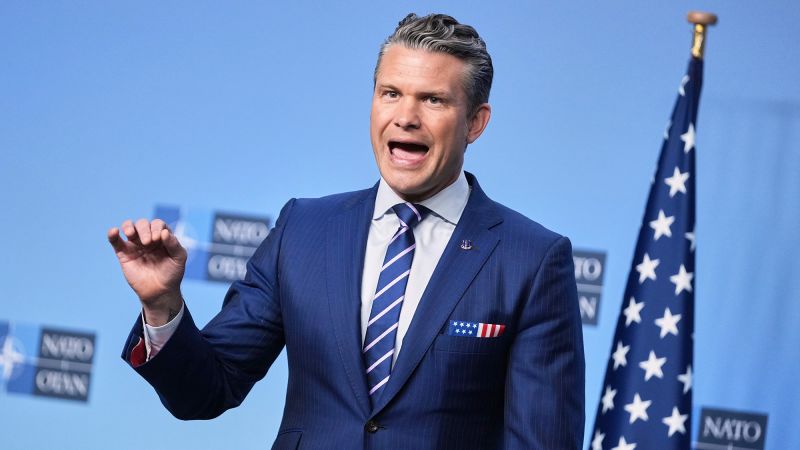World
Hegseth Signals Increased Firepower for Ukraine Ahead of NATO Meeting

United States Secretary of Defense Pete Hegseth announced that increased military support, referred to as “firepower,” is heading to Ukraine through European nations’ purchases of American weapons. This statement came ahead of a NATO defense ministers’ meeting in Brussels. Hegseth emphasized that “commitments” made by European countries will soon translate into “capabilities” for Ukraine, reflecting a concerted effort to bolster the nation’s defense.
The new Prioritized Ukraine Requirements List (PURL) initiative has already seen $2 billion pledged for military equipment. More commitments are anticipated from NATO nations during the meeting. Ukraine is particularly interested in acquiring sophisticated long-range Tomahawk missiles through this initiative, but the decision ultimately lies with U.S. President Donald Trump. President Volodymyr Zelensky is expected to advocate for this access in a meeting with Trump on March 15, 2024, at the White House.
While Zelensky’s request for Tomahawks remains a pivotal point in discussions, it was not officially on the agenda for the NATO meeting. Mark Rutte, NATO’s Secretary General, categorized it as a “bilateral question,” indicating it is a matter for direct discussions between Ukraine and the United States.
In the meantime, NATO defense ministers have committed to providing more drones for Ukraine. The United Kingdom has pledged to deliver 100,000 drones, while the Netherlands has allocated €90 million (approximately $104 million) to support Ukraine in developing its own capabilities.
The backdrop of these discussions includes recent Russian incursions into the airspace of NATO nations. Notably, NATO aircraft shot down suspected Russian drones over Poland last month, marking the first military engagement of this nature in the ongoing conflict. Russia has denied any intentional violation of NATO airspace, asserting that its actions are being misinterpreted.
In response to these threats, Britain’s Defence Minister John Healey stated, “If NATO is threatened, we will act, and we must meet his (Putin’s) escalation with our strength.” He confirmed that British aircraft will continue operations in Polish airspace for the remainder of the year, condemning the Russian incursions as “reckless, dangerous, and totally unacceptable.”
Conversely, Dutch Defense Minister Ruben Brekelmans indicated that Europe requires more effective responses than fighter jets to counter the drone threat posed by Russia. He commented on the performance of Dutch F-35s in neutralizing some drones, but emphasized the need for improved strategies to deal with aerial threats.
Warnings about Russia’s long-term intentions were echoed by Finland’s Defense Minister Antti Hakkanen, who remarked that the country is preparing for possible future aggression after the conflict in Ukraine subsides. He pointed to Russia’s military modernization and troop build-up near NATO borders as indicators of ongoing risks.
As discussions unfold at NATO, the focus remains on how European nations can effectively support Ukraine while addressing the escalating threats from Russia. The alliance’s commitment to defending its members and supporting Ukraine is likely to evolve in the coming weeks as these geopolitical dynamics continue to shift.
-

 Science2 weeks ago
Science2 weeks agoIROS 2025 to Showcase Cutting-Edge Robotics Innovations in China
-

 Politics2 weeks ago
Politics2 weeks agoJudge Considers Dismissal of Chelsea Housing Case Citing AI Flaws
-

 World2 weeks ago
World2 weeks agoBravo Company Veterans Honored with Bronze Medals After 56 Years
-

 Lifestyle2 weeks ago
Lifestyle2 weeks agoStone Island’s Logo Worn by Extremists Sparks Brand Dilemma
-

 Top Stories2 weeks ago
Top Stories2 weeks agoIndonesia Suspends 27,000 Bank Accounts in Online Gambling Crackdown
-

 Sports2 weeks ago
Sports2 weeks agoMel Kiper Jr. Reveals Top 25 Prospects for 2026 NFL Draft
-

 Health2 weeks ago
Health2 weeks agoStartup Liberate Bio Secures $31 Million for Next-Gen Therapies
-

 Health2 weeks ago
Health2 weeks agoTop Hyaluronic Acid Serums for Radiant Skin in 2025
-

 World2 weeks ago
World2 weeks agoHoneywell Predicts Record Demand for Business Jets Over Next Decade
-

 Politics2 weeks ago
Politics2 weeks agoNew Jersey Voters Urged to Register Ahead of November Election
-

 Lifestyle2 weeks ago
Lifestyle2 weeks agoMary Morgan Jackson Crowned Little Miss National Peanut Festival 2025
-

 Sports2 weeks ago
Sports2 weeks agoYamamoto’s Mastery Leads Dodgers to 5-1 Victory in NLCS Game 2









